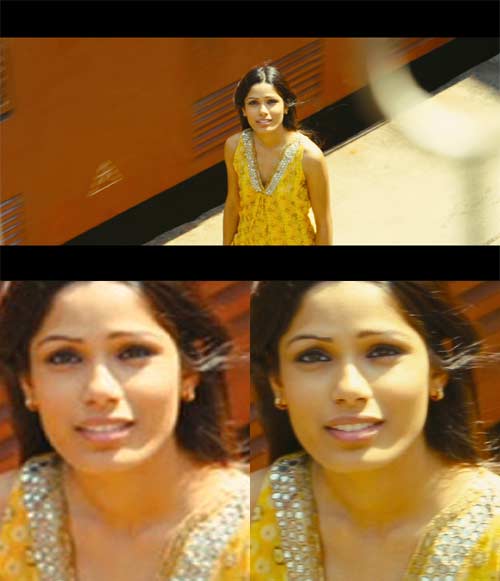 Picture:
Picture:  Sound:
Sound:  Extras:
Extras: 
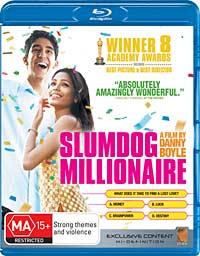
Movie:  Picture:
Picture:  Sound:
Sound:  Extras:
Extras: 
But Danny Boyle has a habit of creating something special from surprising material (see Trainspotting and 28 Days Later ..., for example).
What's especially interesting here is that this disc is from Icon Film Distribution, rather than one of the majors, and consequently is very different to the US version. That version gets an MPEG4 AVC transfer, while our version gets VC1. Both versions get DTS-HD Master Audio sound, but their version gets 24 bits while ours makes do with 16 bits.
We get the 'SLUMDOG DISCovered' feature, they don't. This feature includes an intermittent BonusView PIP, plus a pop-up invitation to branch-off to see deleted scenes, making-of featurettes and the like, along with explanatory text panels. All the video material, other than the PIP content, is separately viewable under the Special Extras menu.
So how good is the picture in the Australian version? I have read at least one review complaining of the picture quality in the US version, and the same complaints apply to our version. But they are all to do with how the movie was filmed, and nothing to do with the transfer. The shooting used digital video and film. The film used encompassed several brands and types. Clearly much of the film is shot hand-held, and some over-exposed, some under-exposed and forced in development. There is motion smearing and odd camera angles all the time. The movie isn't shot to deliver an artful three dimensional effect, nor razor clarity. It is shot in a way designed to make the images before your eyes enhance the emotion of the story.
The transfer itself it excellent. It faithfully captures the grain and, where available, the sharpness. It delivers the colours and the shades of the Taj Mahal and the slums with fidelity. Nothing more can be asked of a transfer.
My guess, in any case, is that much of the non-clarity was chosen to make that moment when Latika appears at the train station -- standing alone in superb focus in a smeared world -- truly pop in the eye, and in the mind.
And then there is the sound. I have no idea what the 24 bit US version sounds like, but I'd be surprised if there were any discernible improvements over the 16 bit Australian version. The sound just envelopes the listener -- if equipped with an effective speaker system. I'm not sure that it would work well with the speakers built into most TVs. DTS-HD Master Audio doesn't provide for dynamic range compression, so I suspect some volume riding would be in order to watch it that way. Some passages of the movie have a musical accompaniment which is markedly louder than the dialogue, and so could stress out the speakers.
But with a good sound system ... well, wow! Whether it's the buzz of flies around the children as they sleep in the dump, or sounds of crowded streets, or the highly rhythmic music, it is ever present, all around and totally convincing.
Perhaps that 24 bit sound might have added something, but it would have come at a cost of nearly doubling the average audio bitrate to just under 4,000kbps. Given the load in the bitstream of also carrying (from time to time) 480p24 video for the PIP, that may have been just a bit too much.
 (Australian rating); Region B locked; Most extras in 1080i50 or 576i50 format
(Australian rating); Region B locked; Most extras in 1080i50 or 576i50 format
The following video bitrate graph was generated by BDInfo 0.5.3:
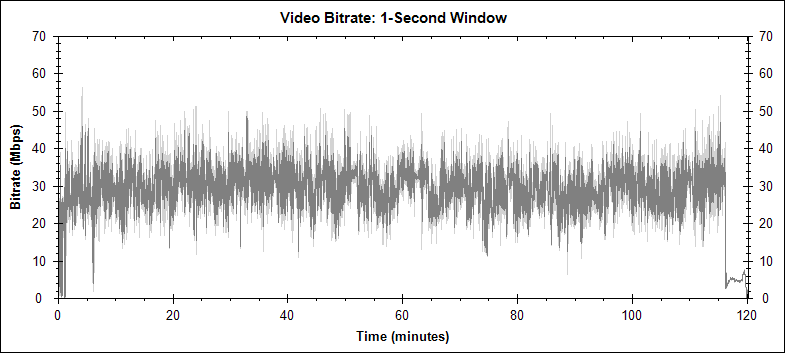
And the following video bitrate graph is for the PIP stream of this movie, showing where the PIP sections occur:
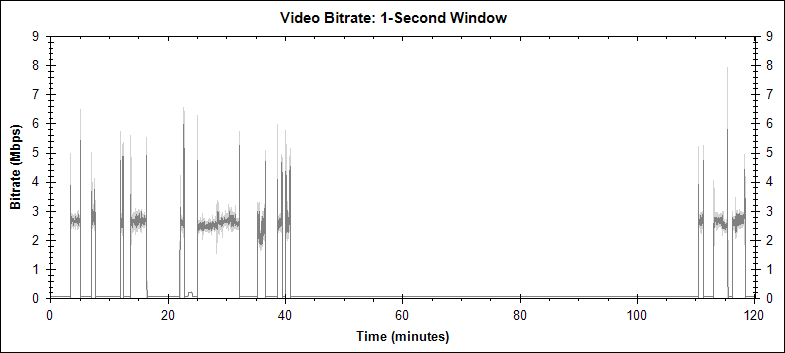
In the following examples, at the top of each is the full frame (suitably shrunk down) used in the comparison, with a 250 pixel wide detail from the frame underneath. The left side is from the PAL DVD. The image was captured digitally from the disc, scaled up from its native 720 by 576 resolution to 1,024 by 576 (to present in the 16:9 aspect ratio), and then, in order to be comparable to the Blu-ray version, from that to 1,920 by 1,080. The detail is from that last scaled version, and has not been rescaled again. The right side is from the Australian Blu-ray. This has not been scaled at all.
The detail is from that last scaled version, and has not been rescaled again. The right side is from the Australian Blu-ray. This has not been scaled at all.
Different applications were used to capture the two frames, so I am not normally comfortable comparing the colour between the two, merely the detail and sharpness. However the DVD does seem to have a slight pink cast, which is thankfully absent from the Blu-ray. For those visitors from NTSC lands, generally the PAL DVD is just a touch sharper than the NTSC DVD.
This movie is variable in film and other capture media used, along with cinematography techniques. The TV studio scenes tend to be a little softer in focus than other scenes, presumably to give a more authentic feel, but even they benefit from Blu-ray:
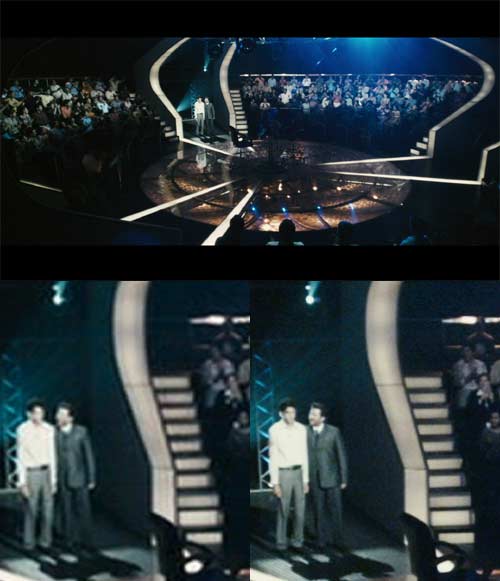
This overhead shot benefits a fair bit from Blu-ray:
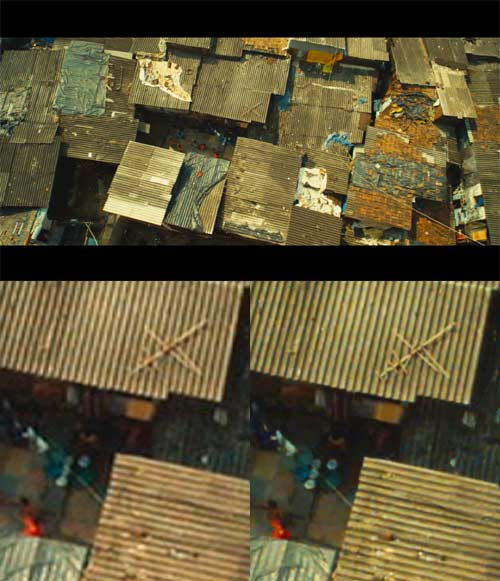
While this one reveals how much sheer detail Blu-ray has to offer compared to DVD:
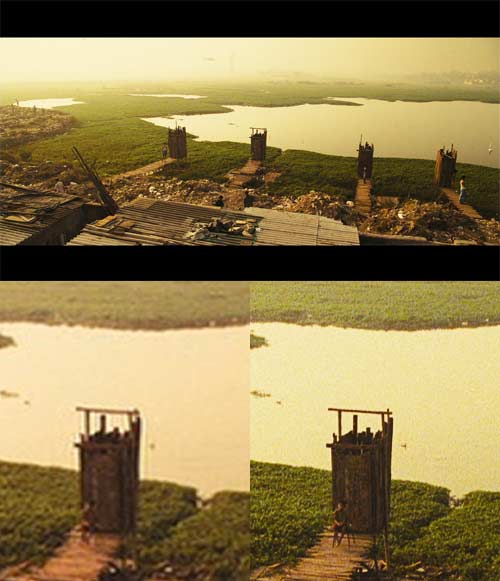
Much of the wetness is quite unseen on the DVD:
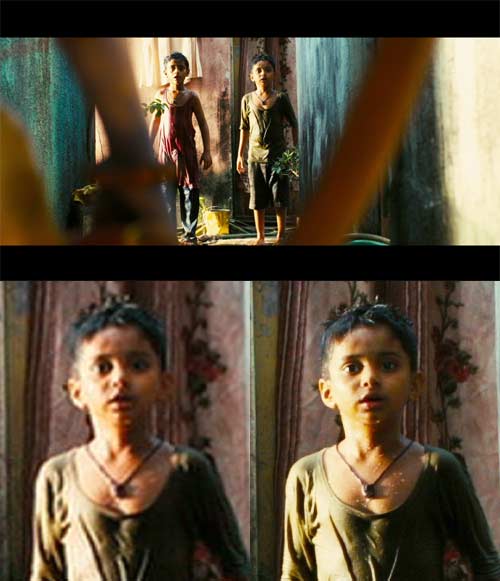
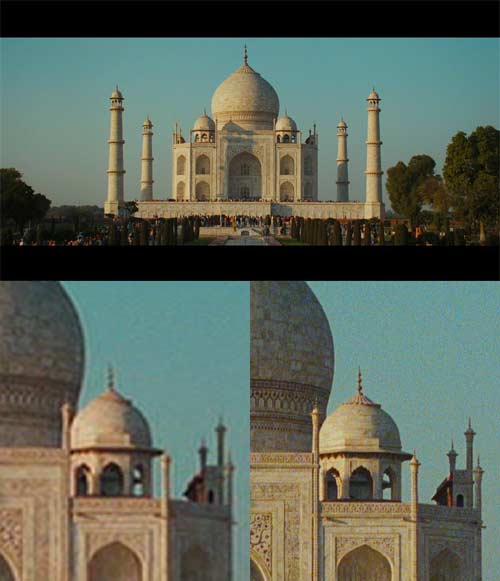
Latika is supposed to stand out by her sharpness and clarity against a smeared, dynamic background. Much of the impact is lost with the DVD:
